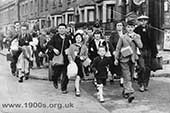World War Two evacuations: why, where from and where to

In anticipation of the blitz of WW2, the British Government set up a scheme known as Operation Pied Piper by which children could be sent out of towns and cities into rural areas to avoid likely maiming and death in WW2 air raids. This page considers the reasons for the evacuations and the most used rural areas. Evacuation was not a total success. Children's evacuee experiences and what it was like for the host households are considered on other pages.
____
By the webmaster based on visits to museums and discussions with older people for whom evacuations were experienced firsthand
Why children were evacuated in WW2 - Operation Pied Piper
The Germans had bombed Britain during the First World War, but not extensively because the weapons were in their infancy. Much worse was to be expected in the Second World War. To avoid maiming and death due to the anticipated air raids and gas attacks, the British Government decided to evacuate children out of towns and cities to rural areas which were regarded as safe. This was to be voluntary, but there was much publicity which implied that loving parents ought to let their children be evacuated for their own safety.

Poster showing Hitler encouraging mothers not to let children be evacuated to safety
Evacuation locations
Kent, Sussex and Essex, were initially included as safe rural areas, but later evacuations were to further inland.
A problematic evacuation location
contributed by Alison Tomlin, personal experience
During the war the Salford and Manchester areas were less built-up and were thought of as separate towns. So some children from Manchester were evacuated to my parents on the outskirts of Salford even though this was only about five miles away. Not surprisingly this evacuation didn't make the children any safer! The whole area was very heavily bombed in 1940 and 1941, with attacks particularly aimed at the Old Trafford industrial area and the Manchester Ship Canal. The bombing was inaccurate and at least one bomb fell in my parents' street. So the evacuees' mother took her children back home, because she could see they were no safer with my parents than they were in Manchester with her.
Practice evacuation routines
Evacuation was a huge logistic effort, and schools in heavily populated areas practised the march to their local station even before the war began.
The following photos shows a typical practice march. Note how long the crocodile of children is, stretching into the distance.
Tap/click for larger legible versions
| sources | webmaster | contact |
Text and images are copyright
If you can add anything to this page or provide a photo, please contact me.





